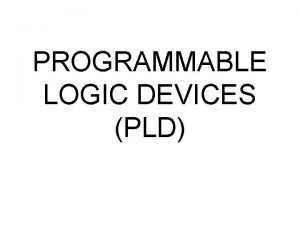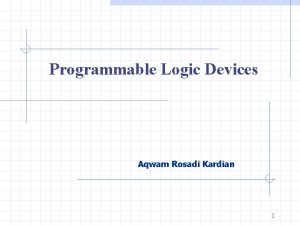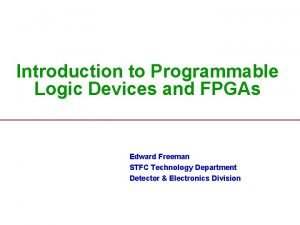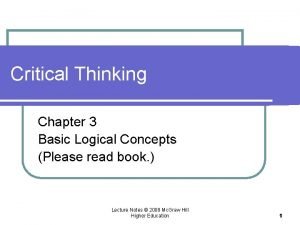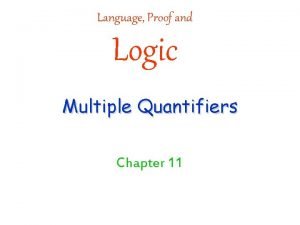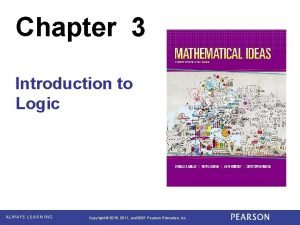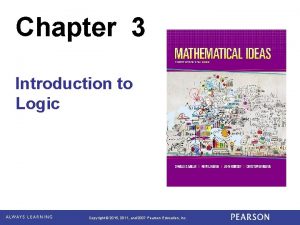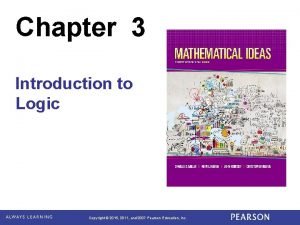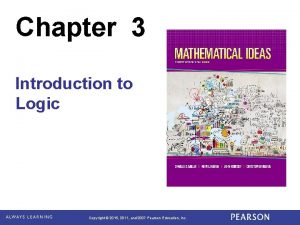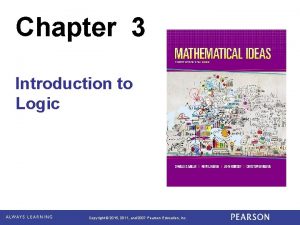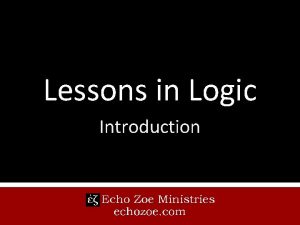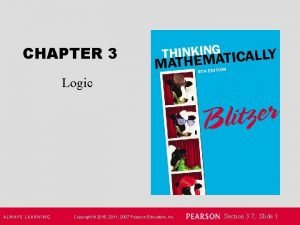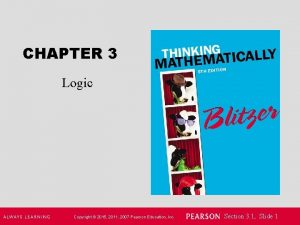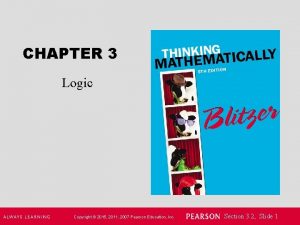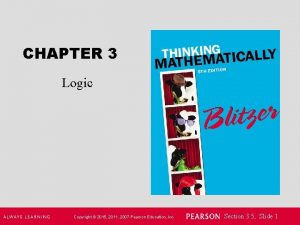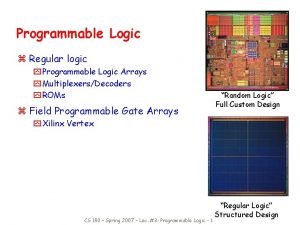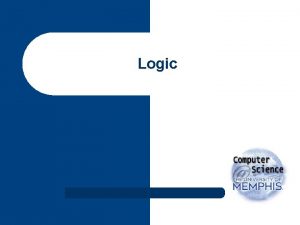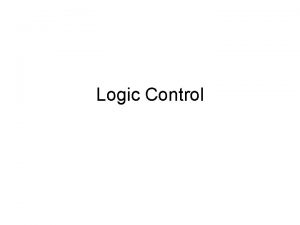Chapter 3 Introduction to Logic Copyright 2015 2011


















- Slides: 18

Chapter 3 Introduction to Logic Copyright © 2015, 2011, and 2007 Pearson Education, Inc.

Chapter 3: Introduction to Logic 3. 1 3. 2 3. 3 3. 4 3. 5 3. 6 Statements and Quantifiers Truth Tables and Equivalent Statements The Conditional and Circuits The Conditional and Related Statements Analyzing Arguments with Euler Diagrams Analyzing Arguments with Truth Tables Copyright © 2016, 2012, and 2008 Pearson Education, Inc. 2

Section 3 -1 Statements and Quantifiers Copyright © 2016, 2012, and 2008 Pearson Education, Inc. 3

Statements and Qualifiers • Distinguish between statements and nonstatements. • Compose negations of statements. • Translate between words and symbols. • Interpret statements with quantifiers and form their negations. • Find truth values of statements involving quantifiers and number sets. Copyright © 2016, 2012, and 2008 Pearson Education, Inc. 4

Statements A statement is defined as a declarative sentence that is either true or false, but not both simultaneously. Copyright © 2016, 2012, and 2008 Pearson Education, Inc. 5

Compound Statements A compound statement may be formed by combining two or more statements. The statements making up the compound statement are called the component statements. Various connectives, such as and, or, not, and if…then, can be used in forming compound statements. Copyright © 2016, 2012, and 2008 Pearson Education, Inc. 6

Example: Deciding Whether a Statement is Compound Decide whether each statement is compound. a) You can pay me now, or you can pay me later. b) My pistol was made by Smith and Wesson. Solution a) The connective is or. The statement is compound. b) This is not compound since and is part of a manufacturer name and not a logical connective. Copyright © 2016, 2012, and 2008 Pearson Education, Inc. 7

Negations The sentence “Max has a valuable card” is a statement; the negation of this statement is “Max does not have a valuable card. ” The negation of a true statement is false and the negation of a false statement is true. Copyright © 2016, 2012, and 2008 Pearson Education, Inc. 8

Example: Forming Negations Form the negation of each statement. a. That city has a mayor. b. The moon is not a planet. Solution a. That city does not have a mayor. b. The moon is a planet. Copyright © 2016, 2012, and 2008 Pearson Education, Inc. 9

Inequality Symbols Use the following inequality symbols for the next example. Symbolism Meaning a is less than b a is greater than b a is less than or equal to b a is greater than or equal to b Copyright © 2016, 2012, and 2008 Pearson Education, Inc. 10

Example: Negating Inequalities Give a negation of each inequality. Do not use a slash symbol. Solution Copyright © 2016, 2012, and 2008 Pearson Education, Inc. 11

Symbols To simplify work with logic, we use symbols. Statements are represented with letters, such as p, q, or r, while several symbols for connectives are shown below. Connective and or not Symbol Type of Statement ~ Conjunction Disjunction Negation Copyright © 2016, 2012, and 2008 Pearson Education, Inc. 12

Example: Translating from Symbols to Words Let p represent “It is raining, ” and let q represent “It is March. ” Write each symbolic statement in words. Solution a) It is raining or it is March. b) It is not the case that it is raining and it is March. Copyright © 2016, 2012, and 2008 Pearson Education, Inc. 13

Quantifiers The words all, each, every, and no(ne) are called universal quantifiers, while words and phrases such as some, there exists, and (for) at least one are called existential quantifiers. Quantifiers are used extensively in mathematics to indicate how many cases of a particular situation exist. Copyright © 2016, 2012, and 2008 Pearson Education, Inc. 14

Negations of Quantified Statements Statement Negation All do. Some do not. Some do. None do. Copyright © 2016, 2012, and 2008 Pearson Education, Inc. 15

Example: Forming Negations of Quantified Statements Form the negation of each statement. a) Some cats have fleas. b) Some cats do not have fleas. c) No cats have fleas. Solution a) No cats have fleas. b) All cats have fleas. c) Some cats have fleas. Copyright © 2016, 2012, and 2008 Pearson Education, Inc. 16

Sets of Numbers p. 88 (chart) Natural (counting) {1, 2, 3, 4, …} Whole numbers {0, 1, 2, 3, 4, …} Integers {…, – 3, – 2, – 1, 0, 1, 2, 3, …} Rational numbers May be written as a terminating decimal, like 0. 25, or a repeating decimal, like 0. 333… Irrational {x | x is not expressible as a quotient of integers} Decimal representations never terminate and never repeat. Real numbers {x | x can be expressed as a decimal} Copyright © 2016, 2012, and 2008 Pearson Education, Inc. 17

Example: Deciding Whether the Statements are True or False Decide whether each of the following statements about sets of numbers is true or false. a. There exists a whole number that is not a natural number. b. Every integer is a natural number. Solution a. This is true (0 is it). b. This is false; – 1 is an integer and not a natural number. Copyright © 2016, 2012, and 2008 Pearson Education, Inc. 18
 Copyright 2015 all rights reserved
Copyright 2015 all rights reserved Copyright © 2015 all rights reserved
Copyright © 2015 all rights reserved First order logic vs propositional logic
First order logic vs propositional logic First order logic vs propositional logic
First order logic vs propositional logic First order logic vs propositional logic
First order logic vs propositional logic Concurrent vs sequential
Concurrent vs sequential Cryptarithmetic problem logic+logic=prolog
Cryptarithmetic problem logic+logic=prolog 캠블리 단점
캠블리 단점 Majority circuit
Majority circuit Combinational logic sequential logic 차이
Combinational logic sequential logic 차이 Logic chapter three
Logic chapter three Pld diagram
Pld diagram Fixed logic devices examples
Fixed logic devices examples Introduction to programmable logic devices
Introduction to programmable logic devices Advantages of pld
Advantages of pld Critical thinking chapter 2
Critical thinking chapter 2 Common patterns of inductive reasoning
Common patterns of inductive reasoning Logic chapter 3
Logic chapter 3 Language proof and logic solutions chapter 11
Language proof and logic solutions chapter 11











